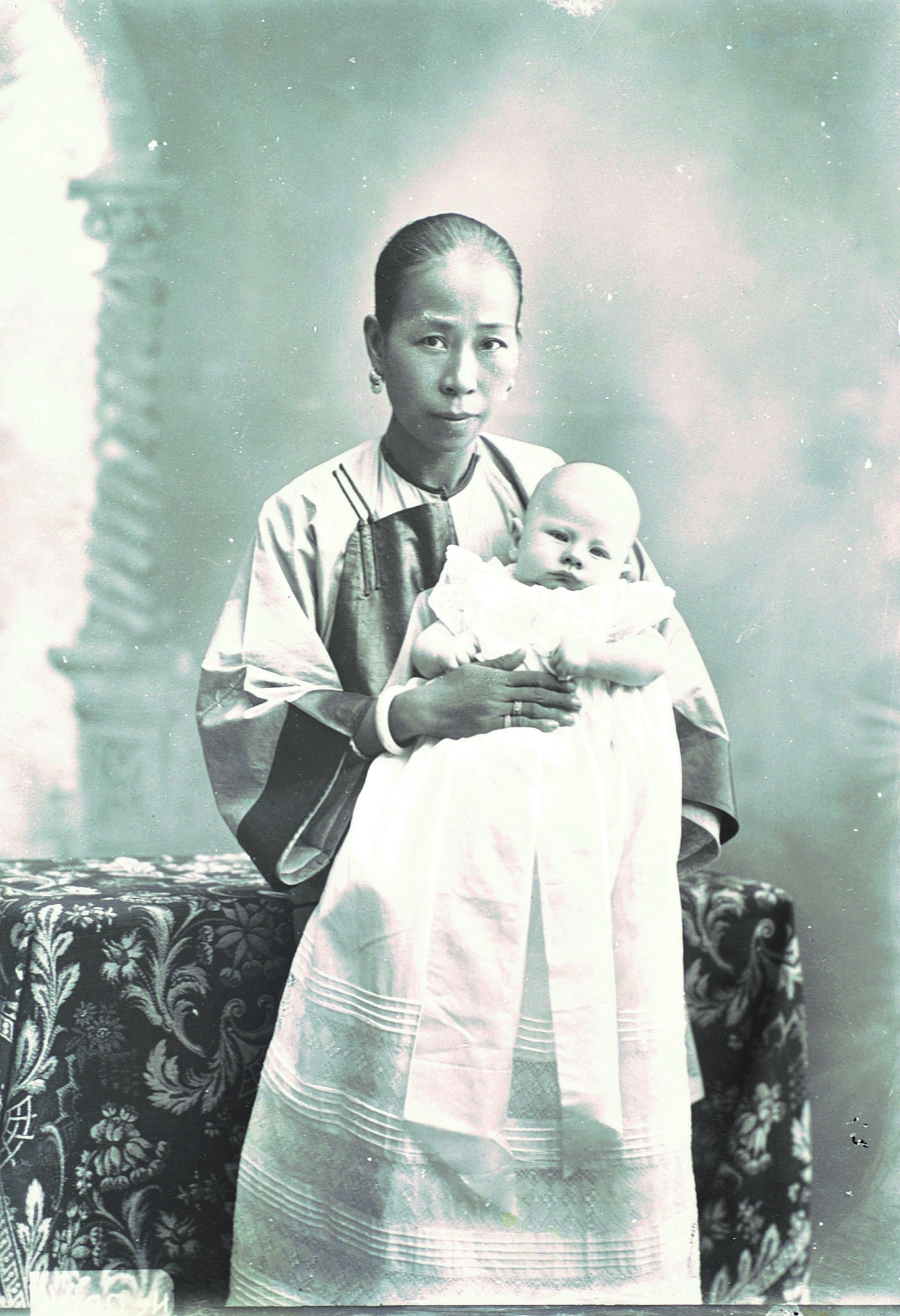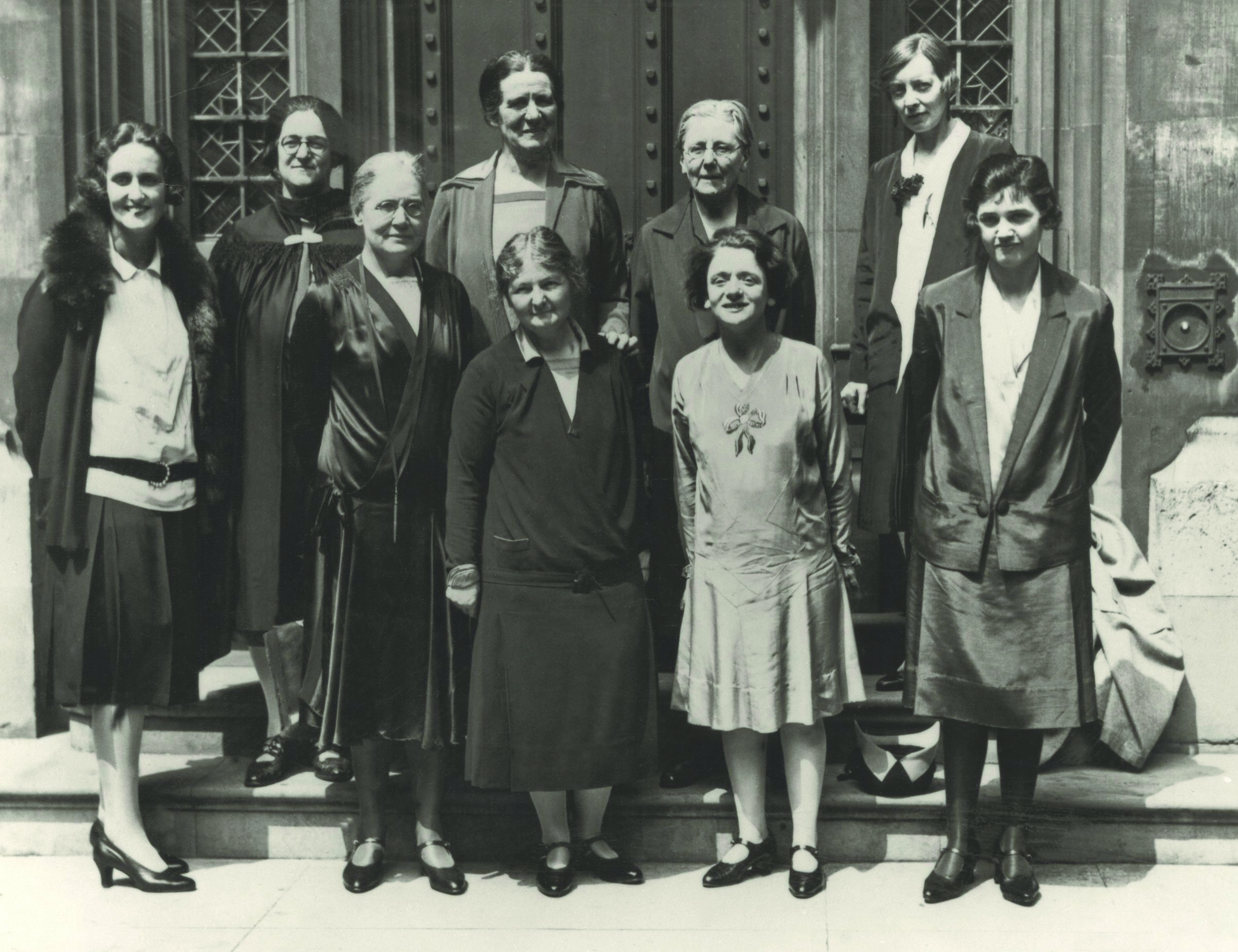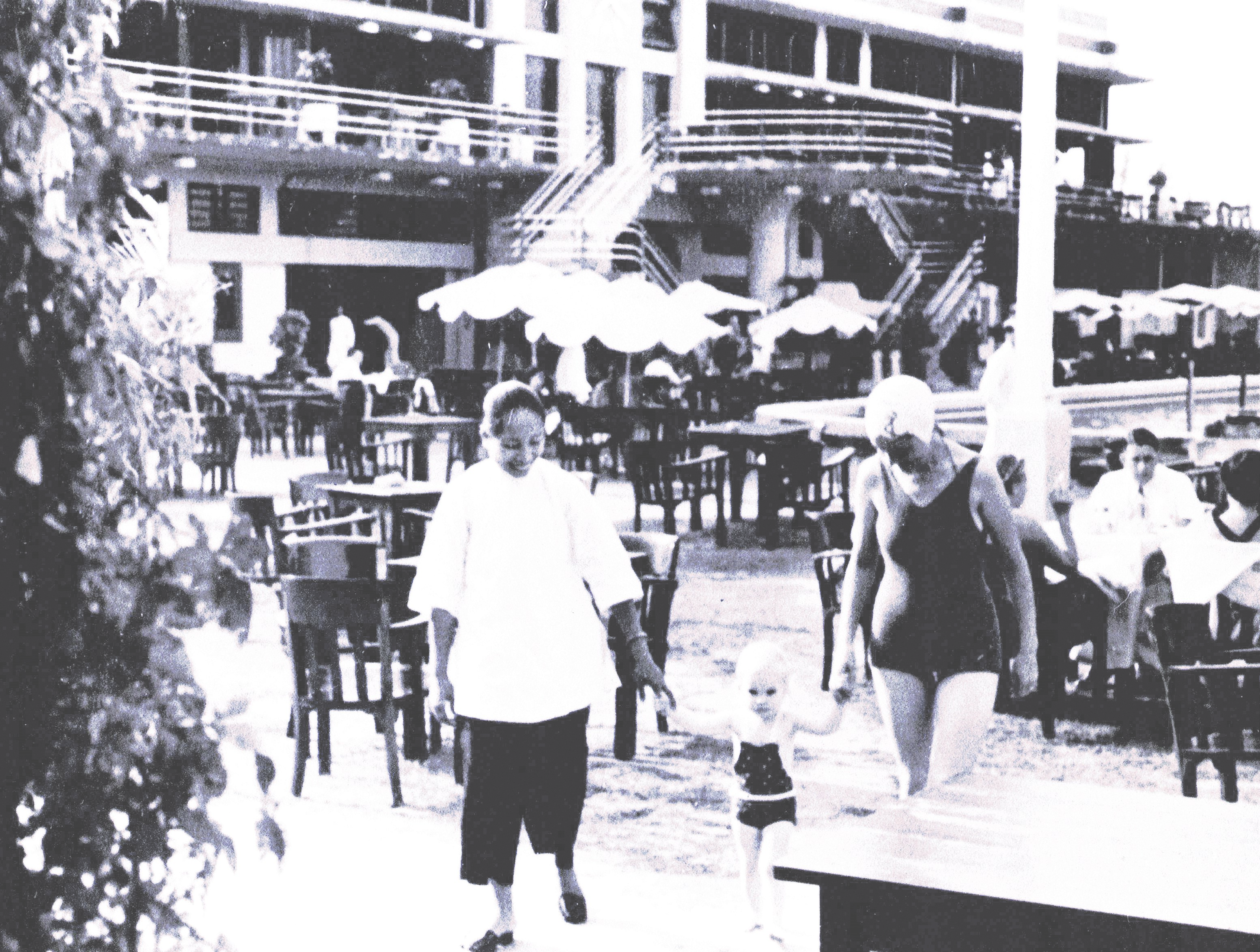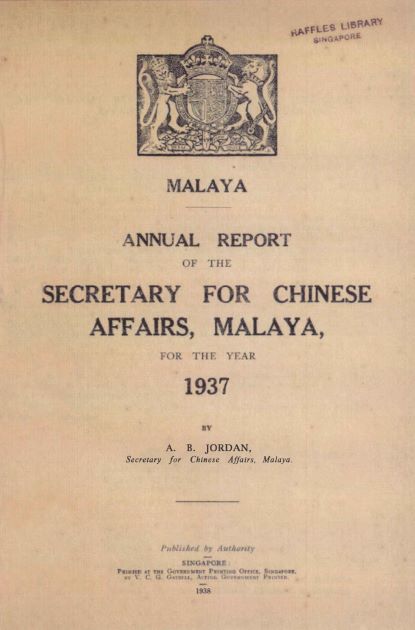Imperial Anxieties: The Civilising Mission & Mui Tsai in the British Crown Colonies
Research Associate Yee Yeong Chong examines the issues arising from the passing of the Mui Tsai Ordinance, and revisits the tensions surrounding events unfolding around the Mui Tsai Commission in Malaya.

We are dealing with a continually changing population, and, as everybody knows, away back for centuries past there have been social customs, as regards polygamy, the sale of children, and all the rest of it, inherent in Chinese life which are repugnant to our ideas and are extremely difficult to tackle, with a shifting Chinese population and particularly with a Chinese population so many of whom are living, not in houses, but in boats… We have set our hands to the plough to eradicate or mitigate the evils from those customs, and we are not going to turn back.
— William Ormsby-Gore
Colonial Secretary, Statement on the Mui Tsai Commission Report, House of Commons, 2 June 1937, London1
With the passing of the Mui Tsai Ordinance in 1932 in Malaya, the practice of employing female child servants within Chinese households quickly fell out of favour.2 The decline of mui tsai (妹仔; a euphemism for “little sister” in Cantonese), however, was not a straightforward affair for the British Colonial Office, who found themselves embroiled in a delicate tussle between anti-slavery and white feminist lobby groups, the Chinese elite, and the Protestant Church in Hong Kong and Malaya.3 The moral outrage, as expressed by abolitionists, was that the Colonial Office had turned a blind eye to the Chinese tradition of owning slave girls in its dominion, a custom that was unbefitting of western civilisation.

Here lay a dilemma for the British Empire: how were the officials to “civilise” the Chinese without demolishing constructed boundaries between themselves as “enlightened masters” and their “backward subjects”? Conversely, in deferring to the Chinese out of respect for their customs, thereby maintaining those boundaries, how would the British Crown uphold its moral ground as the harbinger of civilisation? To quote Ania Loomba, this anxiety over the intrusiveness of colonial intervention highlights a contradiction about colonialism itself: “it needs both to ‘civilize’ its ‘others’ and to fix them into ‘otherness’”.4 As a motif of Britain’s self doubt over the colonial enterprise, the protracted process of abolishing mui tsai in the crown colonies carried far greater social and political impact than a mere matter of administration. Eviscerated in the process are the assumptions of who and what constituted the categories of coloniser/colonised, as with the often taken-for-granted ideas of a monolithic and omnipotent British Empire. These emerging doubts could – and in fact did – eventually force the British to reassess the basis of European cultural superiority.
This article briefly revisits some of these tensions as events surrounding the Mui Tsai Commission unfolded in Malaya.5 Following mounting pressure in Hong Kong to reform bonded servitude, colonial officials dispatched a team to survey local opinions on the mui tsai, culminating in the Mui Tsai Commission Report in 1937. More than just providing insight into the bureaucratic process of colonial knowledge production and racial classification, the discordant positions between the Majority and Minority Reports in the Commission’s findings paint a picture of competing visions of the British Empire. These polarised positions elucidate yet another episode in the long history of colonialism’s unresolved tension between the particularism of imperial exploitation and the universalistic discourse on freedom and social progress.
Constructing Chinese Domestic Mastery
On 18 March 1936, Colonial Secretary J.H. Thomas appointed Sir Wilfrid Woods, Edith Picton-Turbervill and C.A. Willis as members of a Mui Tsai Commission to:
“investigate the whole question of mui tsai in Hong Kong and Malaya and of any surviving practices in those territories of transferring women and children for valuable consideration, whether on marriage or adoption, or in any other circumstances, and to report to the Secretary of State on any legislative or other action which they may consider practicable and desirable in relation to these matters.”6
Thus began the group’s journey to Hong Kong and Malaya in 1936. In their tour of the colonies, local officials and prominent members of the Chinese community including the mercantilist Lee Kong Chian were interviewed. The Commission report, spanning over 200 pages, would be accompanied by 600 pages of interview transcripts and written responses to a questionnaire. A large proportion of the evidence was dedicated to ascertain if the cultural practice of mui tsai was an entrenched practice among the Chinese, as well as to determine the structural conditions of abuse, if present.
Such ethnographic endeavours have long been regarded as techniques of surveillance that reinforce western constructions of native culture.7 Edward Said has famously argued that the representations of the “Orient” in European texts, travelogues, interview transcripts and other writings contributed to the creation of a dichotomy between Europe and its “others”. This dichotomy was central to the creation of European culture as well as the extension of its hegemony over foreign lands. Since the 1860s, a large colonial bureaucracy thus occupied itself with indexing people and their attributes through censuses and ethnographies, recording exchanges, documenting practices and classifying routines.8 This commitment to empirical observation inadvertently generated and reaffirmed European perceptions of natives, framing indigenous people in what appeared to be characteristic behaviours; racial stereotypes were very much by-products of colonial encounters.9
In many colonies, colonisers regarded the position of women within the family and religious practices as indicative of degenerative native culture.10 Ann Stoler (2002) has demonstrated the management of domestic affairs within colonial households to be an important boundary marker and a symbol/expression of colonial power in Sumatra. Claire Lowrie’s study of bonded servitude in Singapore and Darwin has similarly argued:
“The symbolic and practical significance of domestic mastery to colonial power meant that in the colonial scheme of things, a good and moral domestic master constituted a good and moral coloniser. Thus, the discourse of the corrupting Chinese master not only condemned non-white domestic mastery while elevating white domestic mastery, it dismissed the Chinese as capable of colonial mastery. It inferred that while the Chinese had the class power and wealth to employ servants, the way they practiced colonial mastery excluded them from coloniser status.”11
The Chinese were not, of course, a monolithic group, but the construction of “othered Chineseness” was critical in locating the heterogeneous Chinese within hierarchies of race and culture.12 These knowledge production techniques involved the coding of the Chinese in ways that rendered them increasingly available for colonisation. Thus, if the mui tsai were demonstrated to be longstanding symptoms of a culture sanctifying slavery, the “deficiency” of Chinese culture would warrant swift colonial intervention to protect vulnerable girls.13
Yet despite the proclamations of erstwhile Colonial Secretary Winston Churchill on 21 March 1922 that he was “determined to effect the abolition of the system” within a year, the appointment of the Duke of Devonshire as the new Colonial Secretary in 1922 dissolved the efficacy of the Female Domestic Service Ordinance instituted under the charge of Churchill.14 Heeding the vehement objections from Hong Kong and London against mandatory registration of servants, Devonshire put off the registration of domestic servants indefinitely in fear of Chinese rebellion. Enthusiasm for the reforming campaign died down and was only revived by feminists in the early 1930s.
This reversal of policy between Churchill and Devonshire was just one of the many well-documented debates on the mui tsai issue. By the time the committee of Woods, Willis and Picton-Turbervill had embarked on their journey to the Far East, the issue had already been in circulation for close to two decades. The eventual commission report would come to represent the final, albeit unsuccessful, move by the British colonial administration to close off an international cause célèbre that had cost them their moral legitimacy. While a recount of these events is not possible in this short discussion, it is noteworthy that the discordant positions within the commission report reiterate a conflict between the British imagination of themselves as benign masters and the hidden transcript of imperial exploitation. The next section briefly explores this tension using excerpts of the Majority and Minority Commission Reports as source material.
Internal Debates Within the Commission
The Majority Report of the Commission, signed by Woods and Willis, emphasised that while abuse of girls did happen, they were infrequent and usually swiftly dealt with, thereby dispensing with the need for an overhaul of the status quo. The report also argued that while the transactions of girls were occurring at a larger scale than the commission was able to identify, the definition of mui tsai made it difficult for the Colonial Office to effect policies that define what her rights were or how she should be treated.15 With the exception to several modifications to existing enforcement practices, the Majority Report was content to “regard the record of the Governments concerned, as giving little, if any, occasion for criticism” and that “the Governments of Hong Kong and Malaya are employing every immediately practicable device available to them to protect girls from the evils of immorality and prostitution”.16 Interestingly, the Majority Report was premised on stereotypes of Chinese as caring masters; Woods and Willis reported how they “were told repeatedly by Europeans with an intimate knowledge of Chinese life that the normal Chinese attitude to children is one of affection and often of over-indulgence”.17 This restated the Colonial Office’s oft-used alibi of cultural difference to defer to the Chinese to self-regulate the practice.
Despite the Colonial Secretary’s insistence that both reports “have a very great deal in common”, the Minority Report by Picton-Turbervill was, in stark contrast, a strong indictment of the colonial state’s reluctance to root out slavery, calling for the reform of child protection laws.18 Not content with the limited definition of mui tsai as “female domestic servants”, Picton-Turbervill recommended an amendment to the Mui Tsai Ordinance to include all transferred children under the age of 12, regardless of gender and adopted or otherwise, who have now come into the care of a family other than those of direct familial ties.19 Once amended, the social category of mui tsai was to be abolished.20 Hence, while the mui tsai issue “had been defined largely in terms of racial opposition or sexual exploitation” before the late 1930s, Picton-Turbervill’s recommendations began a series of challenges that identified age as the key ground for anti-slavery reform.21

Overall, the Minority Report received substantial attention and support because the language of “child protection” appealed to both reformers and officials. However, the government of Hong Kong unanimously rejected the proposals. Even so, the rising tide against the practice meant that many within the British officialdom were already beginning to disassociate themselves as mui tsai apologists. In September 1937, the newly appointed Governor of the Straits Settlements Shenton Thomas surprised many when he decided to support Picton-Turbervill’s Minority Report independently. After garnering the support of Colonial Secretary William Ormsby-Gore, measures were taken to secure the Hong Kong government’s cooperation.
In contrast, there was little resistance to the Minority Report in Malaya and it went largely uncontested. In 1938, the Secretary of Chinese Affairs for Singapore reported:
“The government of the Straits Settlements recommended to the Secretary of State for acceptance, subject to variance of detail necessitated by local conditions, the principle embodied in the Minority Report that all girls must be safeguarded who for any reason whatsoever are transferred when under the age of twelve from their parents to persons other than relatives. It was decided that this could be best done by an amendment of the Children Ordinance and a committee was drafting the necessary legislation at the end of the year. This will provide for notification of the transfer of girls under the age of fourteen and for inspection and supervision where needed. It was expected that the other Malayan Governments would reach the same decision when they had before them the draft of the proposed legislation.”22

Whether Picton-Turbervill’s Minority Report was directly responsible for the legislative about-turn is difficult to determine. While it is clear that her political connections with prominent politicians helped set an abolitionist agenda, her framing of the mui tsai question as an issue of child protection was equally, if not more, significant. As Susan Pedersen argues, officials were beginning to learn that a fiery “rhetoric of social progress” would be better received as a justification for colonial rule in a democratic age, and the commitment to child protection was one of many supplements to that end. Therefore, in offering officials a chance to address the contentious issue without unsettling the ideological foundations of empire, Picton-Turbervill’s stance received little political resistance and unfolded as a straightforward process of humanitarian intervention.
Conclusion
Susan Pedersen (2001) has suggested that the mui tsai controversy appears to be significant because it resulted in a “maternalist” system of checks and balances within a colonial setting; home visits by women inspectors to ensure the wellbeing of girls were instituted at a time when Europe itself was questioning the “policing” of families by the welfare state. Conversely, the extent of such intervention did not immediately translate into an eradication of the system. Maria Jaschok (1988) and Suzanne Miers’ (1994) interviews of former mui tsai in the late 1970s and 1980s revealed that many had not even heard of the mui tsai legislation. At most, child-protection laws provided rudimentary recourse for more fortunate children who managed to escape; it could not transform, much less abolish, the practice of child servitude.23 In the end, the practice declined only gradually, but the outbreak of World War II ensured that child trafficking would persist under other guises. The campaign against the mui tsai acutely disrupted the long-term supply of domestic helpers to Chinese households. With tighter controls on female servants and the dwindling supply of male servants, the economy of domestic service was reconstituted and the postwar demand for unbonded female servants (amah) surged.24

Janet Lim’s autobiography contains a rare first-hand account a mui tsai’s escape from a life of poverty. All rights reserved, Monsoon Books, Singapore, 2004.
Documenting oral history accounts by former mui tsai, many of the interviews compiled in this volume reveal most bonded servants’ lack of familiarity with the legislation intended to protect them. All rights reserved, Zed Books, London and New Jersey, 1988.
Superior Servants is a valuable photo book on the prominence of the Cantonese amahs, charting their journey from Canton to Malaya. All rights reserved, Oxford University Press, Singapore, 1988.
In examining some of the key debates surrounding the Mui Tsai Commission Report, this article has suggested that the arguments for or against the abolishment of bonded servitude reflects a broader decline in the discourse of European cultural superiority. Despite couching the resolution of the mui tsai problem in terms of child rescue, the British metropole was reluctant to conclude that the Chinese were possibly corrupting masters; this demonstrates a lack of conviction about the morality of British colonial mastery in its waning days.25 Moreover, by leaving open the possibility that some middle- and upper-class Chinese might be capable of colonial mastery (as exemplified through domestic mastery), the British could thus avoid long-term responsibility for Malaya.
While the mui tsai has largely faded from public consciousness since the postwar years, the domestic service economy is now an entrenched reality for many Asian societies. With women arriving from the neighbouring countries of Indonesia, the Philippines and South Asia into the “tiger economies” of Hong Kong, Singapore, South Korea and Taiwan, the new rich in Asia are now masters of domestic workers in their own right. Ironically, the legacy of colonialism’s ethno-racialisation of its subjects continues to manifest itself through the exploitation of “darker skinned” domestic workers.26 It remains to be seen if humanitarian groups can be successful in an age where the discourse of rights does not enjoy the luxury of critiquing a clumsy target like “colonialism”; instead, they must now manoeuvre the sociocultural specificities of Asian countries that label the discourse of rights as an inherently “western” construct.
The author acknowledges with thanks Assistant Professor Daniel P.S. Goh from the Department of Sociology, National University of Singapore for reviewing the article.

Research Associate II
Engagement, National Library
REFERENCES
Cheah, P. (2006). “Bringing into the home a stranger far more foreign: Human rights and the global trade in domestic labour,” in Inhuman conditions: On cosmopolitanism and human rights (pp. 78–229). Cambridge, MA: Harvard University Press. (Call no.: R 303.482 CHE)
Cohn, B.S. (1996). Colonialism and its forms of knowledge: The British in India. Princeton, NJ: Princeton University Press. (Call no.: R 954 COH)
Gaw, K. (1988). Superior servants: The legendary Cantonese amahs of the Far East. Singapore: Oxford University Press. (Call no.: RSING 331.481640460951 GAW)
Hirschman, C. (1986, Spring). The making of race in colonial Malaya: Political economy and racial ideology. Sociological Forum, 1 (2), 330–361. Retrieved from JSTOR via NLB’s eResources website.
Jaschok, M. (1988). Concubines and bondservants: The social history. London: Zed Books. (Call no.: R 305.420951 JAS)
Jordon, A.B. (1938). Annual report of the secretary for Chinese affairs, Malaya for the year 1937. Singapore: Malaya, Chinese Secretariat. (Call no.: RRARE 323.1595 MAL; Microfilm no.: NL9716)
Lai, A.E. (1986). Peasants, proletariats and prostitutes: A preliminary investigation in the work of Chinese women in colonial Malaya. Singapore: Institute of Southeast Asian Studies. (Call no.: RSING 331.409595104 LAI)
Lim, J. (2004). Sold for silver: An autobiography of a girl sold into slavery in Southeast Asia. Singapore: Monsoon Books. (Call no.: RSING 940.547252 LIM)
Loomba, A. (1998). Colonialism-Postcolonialism. London; New York: Routledge. (Call no.: RCLOS 325.3 LOO)
Lowrie, C. (2009). In service of empire: Domestic service and colonial mastery in Singapore and Darwin, 1890s to 1930s. University of Wollongong thesis collection. (Call no.: RSING 331.76164046095957 LOW)
Miers, S. (1994). Mui Tsai through the eyes of the victim: Janet Lim’s story of bondage and escape. In M. Jaschok & S. Miers (Eds.), Women and Chinese patriarchy: Submission, servitude, and escape (pp. 108–121). Hong Kong: Hong Kong University Press. (Call no.: R 305.420951 WOM)
Ong, A. (2006). A biocartography: Maids, neoslavery and NGOs. In Neoliberalism as exception: Mutations in citizenship and sovereignty (pp. 195–218). Durham, NC: Duke University Press. (Call no.: R 323.601 ONG)
Pedersen, S. (2001, May). The maternalist moment in British colonial policy: The controversy over ‘child slavery’ in Hong Kong, 1917–1941. Past and Present, 171, 161–202. Retrieved from JSTOR via NLB’s eResources website.
Png, P-S. (1969, March). The Straits Chinese in Singapore: A case of local identity and socio-cultural accommodation. Journal of Southeast Asian History, 10 (1), 95–114. Retrieved from JSTOR via NLB’s eResources website.
Pomfet, D.M. (2008, November). ‘Child slavery’ in British and French Far Eastern colonies 1880–1945. Past and Present, 201, 175–214. Retrieved from JSTOR via NLB’s eResources website.
Smith, C.T. (1981). The Chinese church, labour and elites and the Mui Tsai question in the 1920s. Journal of the Hong Kong Branch of the Royal Asiatic Society, 21, 91–113. Retrieved from JSTOR via NLB’s eResources website.
Stoler, A.L. (2002). Carnal knowledge and imperial power: Race and intimate in colonial rule. California: University of California Press.
UK Parliament. (1937, June 2). House of Commons debates (Vol. 324, cols. 1025–1046). Retrieved from UK Parliament website.
Watson, J.L. (Ed.). (1980). Transactions in people: The Chinese market in slaves, servants, and heir. In Asian and African systems of slavery (pp. 223–250). Berkeley: University of California Press. (Call no.: RSEA 306.810951 MAR)
Watson, R.S. (1991). Wives, concubines and maid: Servitude and kinship in the Hong Kong regions, 1900–1940. In R.S. Watson & P.B. Ebrey (Eds.), Marriage and inequality in Chinese society (pp. 231–255). Berkeley: University of California Press. (Call no.: R 306.810951 MAR)
Wong, E.E.L. (2005). Singapore, my utopia. Singapore: Excelsis Life Works. (Call no.: RSING 331.48164046095957 WON)
Woods, W.W. & Wills, C.A. (1937). Mui tsai in Hong Kong and Malaya: Report of commission (2 vols.). London: His Majesty’s Stationery Office. (Call no.: RCLOS q306.362095125 MUI)
Yuen, K. (2004, December). Theorizing the Chinese: The Mui Tsai controversy and constructions of transnational Chineseness in Hong Kong and British Malaya. New Zealand Journal of Asian Studies, 6 (2), 95–110.
NOTES
-
House of Commons Debates, 2 Jun 1937. ↩
-
Mui Tsai as a social category has been largely defined as “young girls who were sold or transferred for domestic servicing in return for food and shelter” (Lai, 1986, p. 45). Once into adulthood, the mui tsai could either remain in servitude or become married off to a man of her host family’s choice. Such a definition has come under constant scrutiny and debate between reformers and the Chinese ethnic community, and accounts for much of the difficulty of setting up regulations for the registration of mui tsai in Hong Kong and Malaya. ↩
-
The scholarship on mui tsai is rich, with many accounts centred on its roots as part of the abolitionist efforts of the Haselwoods. Susan Pedersen’s lively account is of foundational importance to this article, specifically in laying out the feminist stakeholders and embedding their interactions within the “maternalist” framing of the mui tsai problem as “child rescue”. Carl Smith’s (1981) archival research of Hong Kong also produced an incisive observation that the Chinese in Hong Kong were deeply polarised in their attitudes towards the practice of mui tsai, dividing the territory between the Christians and some members of the Chinese elite. Last but not least, James Watson’s (1980) discussions on the slave trade in Canton as well as Rubie Watson’s (1991) localised accounts of Hong Kong’s domestic service economy added a fuller understanding to the literature review. ↩
-
Bernard Cohn (1996) has contributed immensely to the understanding of colonial categories within the frame of knowledge and rule, where architectures of documentation, cartography and ethnography helped construct ideal types of native “races” thereby cementing race as a fixed category. ↩
-
Cohn, 1996, pp. 5–11. Cohn identifies these “investigative modalities” as foundations on which “facts” about Britain’s colonies were collected. ↩
-
Charles Hirschman (1986) has famously argued that the construction of races in colonial Malaya was partly a by-product of the penetration of colonial interventions in the realm of race relations. ↩
-
Karen Yuen (2004, p. 105) has tracked the construction of colonial knowledge by sinologist E.J. Eitel on Chinese social practices in the long drawn debate over the mui tsai. In the 1880 report on slavery in Hong Kong, he framed the contemporary practice of mui tsai within a broad historical framework, arguing that the custom of purchasing young girls for the performance of the lighter domestic duties became the general practice of all well-to-do families since time immemorial. He ended his report by arguing that the practice reflected the semi-developed state of Chinese culture because the Chinese civilisation was not as advanced as that of Europe, the practice of mui tsai has its legitimation “as the best possible form of social development under the circumstances”. ↩
-
Carl Smith’s (1981) discussion of the contestations between the upper-middle-class Anti Mui Tsai Society against Hong Kong’s Chinese Chamber of Commerce demonstrates the heterogeneity of Chinese opinion on the mui tsai issue. In Singapore, differing perceptions of cultural superiority among the upper-middle-class Straits Chinese reformers polarised the receptivity towards the abolishment of the mui tsai; some associated the British with progress and advancement, while others advocated the preservation of Chinese culture and civilisation (Png, Mar 1969, p. 101). ↩
-
The entrenchment of the custom was discussed in the Report, p. 162. ↩
-
Churchill cited in Pomfet (Nov 2008, p. 188). ↩
-
Ormsby-Gore, House of Commons Debates. ↩
-
See Pedersen, May 2001, p. 182 and Pomfet, Nov 2008, pp. 190–192. This stance was perhaps part of an emerging recognition by the anti-slavery movement that the “maternalist” protection of all children, and not just girls, would enhance the effectiveness of their appeals for reforms. ↩
-
Janet Lim’s autobiography (Lim, 2005; Miers, 1994) is invaluable in highlighting the treatment faced by mui tsai from a first-person perspective. See also the retold biography of Eunice Wong’s (2005) own domestic servant in Singapore. ↩
-
Lai, 1986, pp. 53–54. See also Gaw’s Superior Servants: The Legendary Cantonese Amahs of the Far East (1988), an excellent collection of photos and commentary on the Cantonese amahs, with chapters on the rise and decline of transnational female servitude in Canton and the Straits Settlements. ↩
-
See for instance, Ong (2006) and Pheng (2006), both of whom have focused on the biological and cultural preconditions that shape maid abuse in Asia. Drawing from Hirschman (Spring, 1986), Ong has gone further to argue that some of these features are vestiges of the colonial construction of race. ↩

